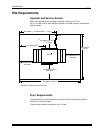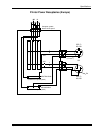
Specifications
September 2000 B-5
Line Voltage
The printer operates satisfactorily over a range of voltages around the nominal
voltage.
The local utility company is required to deliver power usually within ±10% of the
rated value to the main distribution panel in the building. Voltage then drops from
there to the outlets where the equipment is connected. The total voltage drop is a
function of the following factors:
• The composition of the conductor material in the wire. Copper wire is a better
conductor than copper-clad aluminum and aluminum wire, which results in
less voltage loss over the same length of wire.
• The diameter or gauge of the conductor. Large diameter conductor exhibits
less voltage loss than small diameter conductor.
• The length of the circuit. A long circuit layout may result in more voltage loss
than a short, direct circuit layout.
• The load or current on the circuit (amperes). A large circuit load may result in
voltage loss in a circuit.
• The types and number of connections. Several connections in a circuit
increase the chance of improper wiring practices, which could result in voltage
loss.
You must allow for adequate wiring to keep the supplied voltage within the
required range. Otherwise, intermittent data errors and system errors may occur.
Low-voltage problems are more common than high-voltage problems and are
generally caused by poor wiring practices.


















